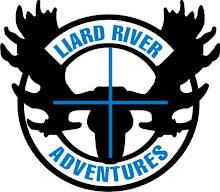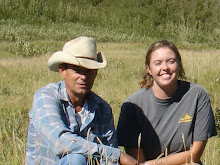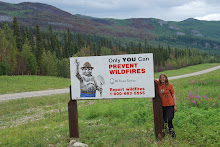 2 years post fire.
2 years post fire.In the beginning of the fall, my research assistants and I hit the exclosures on the Liard to take our 2nd year vegetation samples after Fire 084. We were amazed like many others who have studied the vegetation response in the Boreal after fire. Fire 084 burned through the summer of 2009 and grew to 24,000 ha causing an incredible mosaic of landscape throughout its run. It was actioned along the highway but allowed to run out north away from the major transportation corridor that ties the north to the south.
As you peruse the following pictures, I challenge you to ask yourself some questions:
Why not burn? Is it ecologically sound to write impact assessments on "why an area should burn" when fire has been part of that site's ecological history and evolution?
 Geared up and heading into the burn to set up the plots inside the exclosures constructed in partnership with Liard River Adventures, the Wildfire Management Branch (NIFAC crews), Oklahoma State University and the Range program of the Ministry of Forests and Range.
Geared up and heading into the burn to set up the plots inside the exclosures constructed in partnership with Liard River Adventures, the Wildfire Management Branch (NIFAC crews), Oklahoma State University and the Range program of the Ministry of Forests and Range. Exclosure 1 on the north side of the Liard River, 3 months post fire in 2009.
Exclosure 1 on the north side of the Liard River, 3 months post fire in 2009.How much proof is needed to show that fire is the dominant ecosystem driver in the boreal?
Are humans part of the ecosystem?
What happens to those species who depend on fire, when there is no fire?
 3 months postfire in 2009 - clearly this landscape has been devestated by fire and this plot is a good example of how fire can cause ED - ecosystem dysfunction.
3 months postfire in 2009 - clearly this landscape has been devestated by fire and this plot is a good example of how fire can cause ED - ecosystem dysfunction.What does ecologically sound mean anyways? Function ... functionality ... proper use ... uniform distribution ...
And furthermore, why do we not talk about ecosystem dysfunction or what I will now term as the ecological ED whereby there is an inability to develop or maintain an ecosystem including the proper functioning of all natural processes for satisfactory ecosystem performance?
Tell me what you think ... sonja.leverkus@okstate.edu
 Trevor Scott setting up the plots and spacing inside the exclosures.
Trevor Scott setting up the plots and spacing inside the exclosures. Don Gayton and Ray Couple at exclosure 1 (same as previously shown in 2009) on the north side of the Liard River in 2010 amongst a carpet of Pink corydalis, Dragonhead mint, Bicknell's geranium, moss, grasses and other forbs ... is this system functioning?
Don Gayton and Ray Couple at exclosure 1 (same as previously shown in 2009) on the north side of the Liard River in 2010 amongst a carpet of Pink corydalis, Dragonhead mint, Bicknell's geranium, moss, grasses and other forbs ... is this system functioning? Dr. Marten Geertsema and Ray Coupe at the aspen exclosure in Summer 2010. Is fire bad?
Dr. Marten Geertsema and Ray Coupe at the aspen exclosure in Summer 2010. Is fire bad? The aspen exclosure site 1 year post fire.
The aspen exclosure site 1 year post fire. Using the 1m2 plots inside and outside the exclosure to compare the plant communities in burned and grazed vs burned and ungrazed.
Using the 1m2 plots inside and outside the exclosure to compare the plant communities in burned and grazed vs burned and ungrazed. Some dysfunctional Hairy Wild Rye to the left of Michelle? Max heights for 1 year post fire were up to 160cm ... clearly another case of ED (ecoystem dysfunction)? I would disagree...
Some dysfunctional Hairy Wild Rye to the left of Michelle? Max heights for 1 year post fire were up to 160cm ... clearly another case of ED (ecoystem dysfunction)? I would disagree... Michelle Edwards (formerly of BC Timber Sales) with Dave (as bear watch) from the Hotsprings. Excellent field crew!
Michelle Edwards (formerly of BC Timber Sales) with Dave (as bear watch) from the Hotsprings. Excellent field crew!
Year 2 of Exclosure sampling. Michelle Edwards (formerly of BC Timber Sales) and my mum Dr. Gillian Leverkus and I at the end of sampling. A tip of the hat to Ranger Al for covering bear watch duties for a day in Fall 2010. I owe a big thank you and special recognition to my field crew: Trevor Scott, Gillian Leverkus and Michelle Edwards.
 Me 'n Woody the Wood bison. Woody watched over us while we were doing our vegetation work.
Me 'n Woody the Wood bison. Woody watched over us while we were doing our vegetation work. The 2009 field crew: Gillian Leverkus, Trevor Scott and I - the definition of hard work, outdoor enjoyment and family. Thank you mum and Trevor for believing in me and for all your sweat, blood, guts and tears with me!!!! I am proud to be family with you!
The 2009 field crew: Gillian Leverkus, Trevor Scott and I - the definition of hard work, outdoor enjoyment and family. Thank you mum and Trevor for believing in me and for all your sweat, blood, guts and tears with me!!!! I am proud to be family with you!











































No comments:
Post a Comment